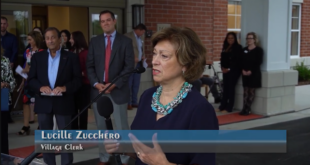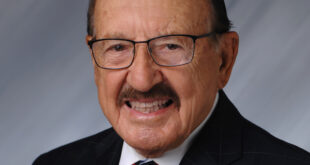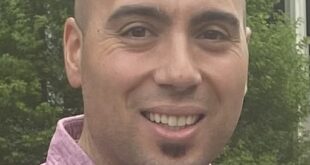NICK BUONICONTI JR.
Undersized for a linebacker, he dominated the NFL gridiron for 14 seasons before making a name for himself in the fields of law, business, broadcasting and medicine.
The hardest thing about profiling Nick Buoniconti Jr. is having enough space on the page. The man accomplished more in one lifetime than most talented people could accomplish in 10. Let’s start from the beginning.
Nick was born on Dec. 5, 1940, in Springfield, Massachusetts, to Nicholas Anthony Buoniconti Sr. and Pasqualina Mercolino, both of whom traced their roots to Naples.
Nick Sr. married into a family that owned an Italian bakery on the South Side of Springfield in a predominantly Italian neighborhood. Nick Sr. worked at the bakery, and Nick Jr. cherished memories of the fresh bread and sausage and peppers that were created and sold there. Despite every possible Italian influence, however, Nick Jr. grew up as an American kid playing American football at Cathedral High School in Springfield.
 Buoniconti was a natural athlete who made a national name for himself on the high school gridiron. By his senior year, he was being highly recruited by major universities from around the country.
Buoniconti was a natural athlete who made a national name for himself on the high school gridiron. By his senior year, he was being highly recruited by major universities from around the country.
Buoniconti thought he might want to go to the University of Southern California, but to his knowledge, he never received a scholarship letter from them. We’ll never really know because his college football recruitment offers were being sent to his high school, where they were processed by one of the Catholic sisters. When Buoniconti noticed that he wasn’t getting offers from some of the schools he was expecting to hear from, he inquired with the nun in charge. As the story goes, the sister said, “Well, didn’t you already get offered a scholarship from Notre Dame?” To which Buoniconti replied, “Yes, that’s the last letter I got.” To which the sister replied, “Well, then, why do you need any more offers? Obviously, you’ll be going to Notre Dame.” As things tended to happen in Catholic schools back then, that settled that, and in 1958 Buoniconti was off to South Bend.
At 5-foot-11 and about 220 pounds, Buoniconti was not considered big for a football player, but his skill, tenacity and instincts for the game made him a great offensive guard and defensive linebacker. In 1960, during his junior year with the Fighting Irish, he was second in tackles, with 71. He led the team in his senior season, with 74, and was named team captain and an All-American.
Folks who say that someone is too small to play in the NFL are usually sports writers who never played the game, and that’s exactly what was being written about Buoniconti when it came time for the pro draft in 1962. He wasn’t picked until the 13th round, when the Boston Patriots of the American Football League selected him.
The Patriots played Buoniconti at linebacker, where he was named Rookie of the Year. In seven years with the Pats, he played in five AFL All-Star games; had 24 interceptions, which still ranks highly in Patriots history; and was named to the AFL All-Time Team. (So much for the sports writers). In 1969, the Pats got their pockets picked when they traded him to the Miami Dolphins just prior to the AFL-NFL merger.
With the Dolphins, Buoniconti played in one more AFL All-Star Game, had eight additional interceptions and two Pro Bowl appearances, and won two Super Bowls during the 1972 and ’73 seasons. He almost had three Super Bowl rings, but the Dolphins lost to the Dallas Cowboys in 1971. Cowboys coach Tom Landry referred to Miami’s defense as the No Name Defense because Buoniconti was the only member with any notoriety. That moniker has since been immortalized along with Minnesota’s Purple People Eaters and Pittsburgh’s Steel Curtain.
Buoniconti never let fame go to his head. At the tail end of his illustrious career, he appeared in one of Miller Lite’s iconic “Do you know me?” commercials. When he proudly announces in a bar that everybody knows he’s Nick Buoniconti, a passerby scrutinizes him and remarks, “No, that’s not it.”
If Buoniconti’s Dolphins had to name one statistic they are most proud of (aside from their two Super Bowl wins), it would have to be their undefeated ’72 season. It’s a record that still stands today, and one that Chicago Bears fans remember all too well. In 1985, Chicago was scheduled to play Miami in Game 13. The Bears were headed for a perfect season with only four games to go. If they achieved their goal, they would have been 16-0 in regular season play, a record that would have eclipsed the Dolphins’ perfect season, which was two games shorter.
Although Buoniconti had already retired from football in 1985, he rallied his ’72 teammates for the Bears/Dolphins game, and they showed up in force at the Orange Bowl to cheer on their team. There is no way to know if the presence of Buoniconti and his teammates factored into the Dolphins’ win that day, but with them cheering from the sidelines, how could the Dolphins possibly lose?
When asked why he was so relentless on the football field, Buoniconti said, “Every play is life or death. I can’t think of anything except the play that’s in front of me.” Being able to focus that way — to be in the moment — is a tremendous asset for a football player. When the situation called for it, however, Buoniconti was just as capable of analyzing the past and foreseeing the future, as he proved upon retiring from football in 1976 after 14 pro seasons.
Buoniconti earned a law degree from Suffolk University Law School while playing with the Patriots. He used his education after his retirement from the game to become a successful attorney, businessman, TV personality and medical pioneer.
In 1983, he worked for the U.S. Tobacco Company, where he was named President and COO at age 44. He was also a sports agent who represented some 30 professional athletes, including Andre Dawson and Bucky Dent. Beyond his performance on the gridiron, however, Buoniconti is probably best remembered for his part in the HBO Sports talk show “Inside the NFL” — cable TV’s longest-running series. He co-hosted the show with Len Dawson for 21 years, from 1980-2001. Buoniconti was inducted into both the Pro Football and the National Italian American Sports halls of fame.
Buoniconti openly shared his struggles with neurological issues stemming from his years in the high-contact world of football. On Nov. 3, 2017, he announced that he would posthumously donate his brain to aid CTE research. He passed away of pneumonia less than two years later — on July 30, 2019 — in Bridgehampton, New York. He was only 78 years old.
Even with all he accomplished, we’re quite sure Buoniconti would say his greatest achievement was the founding of The Miami Project to Cure Paralysis and its international affiliate, The Buoniconti Fund. He immersed himself in this groundbreaking medical effort after his son Marc was paralyzed from the shoulders down in a football accident.
MARC BUONICONTI
Paralyzed from the shoulders down during a fateful college football play, he now helms one of the premier research programs targeting traumatic spinal cord and brain injuries.
Oct. 26, 1985, was a beautiful day in New Jersey. Nick and Terry Buoniconti were visiting Nick’s college roommate, Richard Catenacci, to celebrate their friendship and the blessings they were enjoying in life. Richard was a managing partner of the largest law firm in the state, and Nick, now retired from a stellar professional football career, had transitioned into the worlds of business and broadcasting. (See his profile on page 21.)
On that fateful day, Buoniconti’s son Marc was playing middle linebacker for The Citadel, South Carolina’s premier military institution, in a pitched battle against the East Tennessee State Buccaneers.
Born on Sept. 9, 1966, in Boston, Marc moved to Miami with his family when the New England Patriots traded Nick to the Miami Dolphins in 1969. Marc excelled in sports, but football was his first love. His gridiron prowess earned him a full scholarship to The Citadel and a starting position on the team as a sophomore.
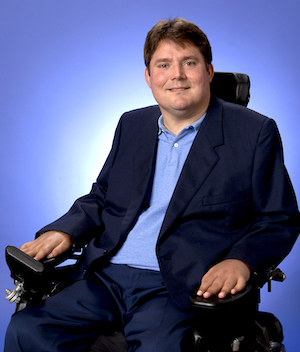 It was third-and-1 against East Tennessee, and the quarterback flipped the ball to their star running back, who angled to Marc’s left. It was a situation that middle linebackers live for: Prevent them from gaining 1 yard and force them to give up the ball. An initial hit by one of Marc’s teammates slowed the runner down but didn’t stop him. Marc knew that success or failure would depend on which one of them could impose their will on the other guy. Running at full speed, Marc laid a second hit on the running back. Perfectly timed and perfectly legal, it was the last hit of his football career. The collision had paralyzed the young linebacker from the shoulders down.
It was third-and-1 against East Tennessee, and the quarterback flipped the ball to their star running back, who angled to Marc’s left. It was a situation that middle linebackers live for: Prevent them from gaining 1 yard and force them to give up the ball. An initial hit by one of Marc’s teammates slowed the runner down but didn’t stop him. Marc knew that success or failure would depend on which one of them could impose their will on the other guy. Running at full speed, Marc laid a second hit on the running back. Perfectly timed and perfectly legal, it was the last hit of his football career. The collision had paralyzed the young linebacker from the shoulders down.
When word reached Nick at the Catenacci home, he felt a different sort of paralysis: not from the impact, but from shock and fear. Football — a game that had given the Buoniconti family so much good fortune — had ultimately betrayed them. When they were reunited at the Johnson City Medical Center in Tennessee, Nick leaned over his traumatized son and said: “Marc, I promise I will do everything in my power to help you walk again.”
Marc’s ensuing battle to survive and eventually thrive in the face of seemingly insurmountable odds could fill a book. In fact, it has. He gave a full account of his struggles in “Undefeated — From Tragedy to Triumph.” The greatest of his challenges was the fact that there was no cure for paralysis.
Once Marc was stable, he was relocated to the University of Miami/Jackson Memorial Hospital under the care of Dr. Barth Green. Both the facility and the doctor were among the best in the world. The Buonicontis had spent countless hours at the hospital with Marc, Dr. Green and other paralyzed patients when, out of sheer frustration, the good doctor remarked: “I’m tired of telling families that their children will be confined to a wheelchair for the rest of their lives. If we could only raise enough money, I’ll bet we could find the cure for paralysis.” That’s all Nick Buoniconti needed to hear.
In less than two months, the Buonicontis put together a fundraising effort led by former Hall of Famer Dick Anderson that fielded donations from everyone from Dolphins fans to American Express, with U.S. Tobacco matching every dime that was collected. The effort raised $300,000, and The Miami Project to Cure Paralysis was born. Unfortunately, taller hurdles stood in the path of the fledgling effort than the need for additional funds.
Many medical professionals scoffed at spending research money on spinal cord injuries, viewing it as a lost cause. Some even objected to using the term “To Cure Paralysis,” fearing it would give people false hope. Obviously, these people didn’t know Marc Buoniconti.
After long, agonizing hours of rehabilitation, Marc learned to breathe without a ventilator and eventually mastered the breath-controlled wheelchair that provides his only mobility. His indomitable spirit propelled him back out into the world, where he earned a degree in psychology from the University of Miami and became an ambassador for The Miami Project. Marc has served on several local, state and federal committees; given hundreds of interviews; spoken at countless public appearances; and inspired millions with his courage.
The founder of Spinal Network and a founding member of the Governor’s Commission for Disabilities for the state of Florida, Marc’s accolades are too numerous to list. Among them are the Spirit Award from ESPN, the Gene Autry Award for Courage, the Iron Arrow Award from the University of Miami, the Lauder Medal from Barry University and the Jefferson Award from the American Institute of Public Service. The Citadel bestowed an honorary doctorate upon him, he was featured on a Wheaties box, and he was inducted into the Good Shepherd and Spinal Cord Injury halls of fame.
“One day, I was a normal kid — thinking about school, sports and girls,” muses Marc. “The next thing you know, I’m out there talking to people about paralysis. My goal is to get everyone out of these wheelchairs.”
To reach that goal, the Buoniconti family established The Buoniconti Fund to Cure Paralysis in 1992. Volunteer chapters throughout the country raise funds and awareness for The Miami Project through golf tournaments, wine tastings, walk-n-roll-a-thons and other events. On the national level, their Great Sport Legends Dinner in New York City draws athletes, medical professionals and benefactors from all over the world.
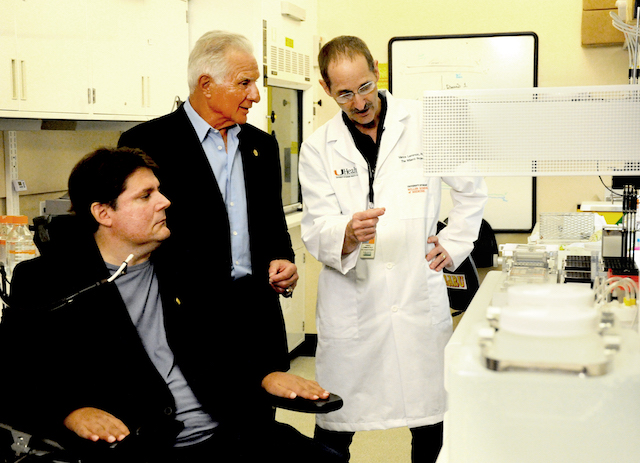
The Miami Project is now in its 28th year, and Marc has been at the helm for the last 20. With a $20 million annual science budget, the organization employs 175 research scientists, clinicians, and support staff who operate basic and clinical research facilities. It is a part of the University of Miami Miller School of Medicine, with offices and basic science operations at the Lois Pope Life Center and clinical research conducted at the Christine Lynn Rehabilitation Center.
Over the decades, The Miami Project has emerged as one of the premier research programs targeting traumatic spinal cord, brain injury and other neurological disorders. Most importantly, they are changing the spinal cord injury paradigm from hopeless to hopeful as they continue their ongoing battle for an actual cure. Their current arsenal includes cell replacement therapy, neuroprotective strategies and brain-computer interface technology. By improving both knowledge and strategies for spinal cord injury and traumatic brain injury, Marc Buoniconti and his staff are truly doing God’s work.
“I believe in my heart that The Miami Project holds tremendous promise for people who are spinal cord injured,” Marc says. “In 1985, The Miami Project was a dream. Today, it’s reality.”
Marc is indeed a quadriplegic, but that’s not what we saw when we interviewed him. We saw a middle linebacker in a chair … on third-and-1 … still ready to dive into the play and impose his will.
The above appears in the May 2023 issue of the print version of Fra Noi. Our gorgeous, monthly magazine contains a veritable feast of news and views, profiles and features, entertainment and culture. To subscribe, click here.
 Fra Noi Embrace Your Inner Italian
Fra Noi Embrace Your Inner Italian




